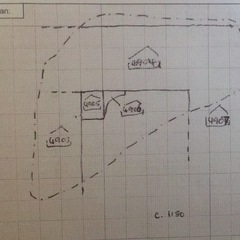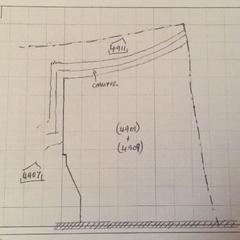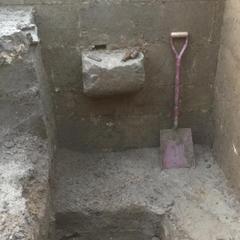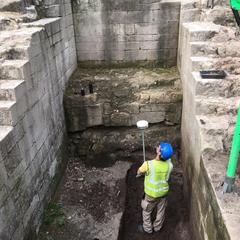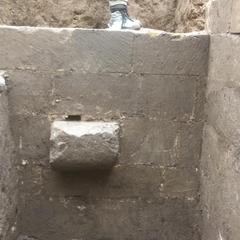Basic Information
- Drawbridge pit
Contexts
Narrative
-
- A large rectangular drawbridge pit – measuring 5.6m long, 2.45m wide and 6.5m deep – was found in the middle of the bridge. As with external faces of the structure, it was constructed entirely with sandstone random ashlar blocks on top of cut bedrock. The north wall had been built where the bedrock was at its highest point and eight courses survived in excellent condition. The west wall was 27 courses deep to the base and the east wall 26 courses. The smaller, 0.55m thick south wall of the pit had been robbed and 17 courses survived; on the third course down slightly worn stone corbels protruded 0.24m from the wall face. These architectural elements had evidently been placed during the initial construction of the wall and probably formed brackets upon which timber uprights were positioned, possibly related to the function of the drawbridge. Three recesses were observed further down the wall. The uppermost depression was roughly circular, measuring 0.12m diameter and 0.1m deep, slightly off-centre and had evidently worn through repeated motion of an object in this space. Below this was a larger, 0.35m deep recess on a similar vertical alignment that also appeared to have formed through repeated striking of a roughly circular object, leading to the removal of the masonry facing. The angle at which the hole had formed suggested striking had occurred from an elevated position. The lowest recess was found three courses from the base of the drawbridge pit and was positioned more centrally. Unlike the other two, this appeared to have formed through the deliberate removal of a square section of wall, possibly to support a horizontal beam; however, no working was found into the bedrock opposite to suggest it spanned the base of the pit. No structural elements were found within the recesses and none contained layers unique to their situation. Mason’s marks were found on each of the faced walls. The east wall contained 15 unique marks, the west wall 13, the south wall four, north wall six.. Many of these marks were found on more than one wall, and there were two instances in the east wall where blocks of masonry were found with two marks. There appeared to be no pattern to the placement of marked stones from the base of the drawbridge pit to the top, suggesting that the gatehouse was constructed as one scheme of work. Vertical striations were found on both the east and west walls, appearing as very faint pale stripes from the top of the walls down towards the base. This pattern was most noticeable on the east wall where three were spaced at 0.75-0.9m intervals from the south wall. These stripes were not cut into the ashlar walls, had not formed through weathering and were observed down almost the full elevation of the walls.
-
- Indie Jago
- 27-4-2021
Dating Narrative
-
- Phase 2 – Gatehouse construction (14th century)
-
- Indie Jago
- 27-4-2021
